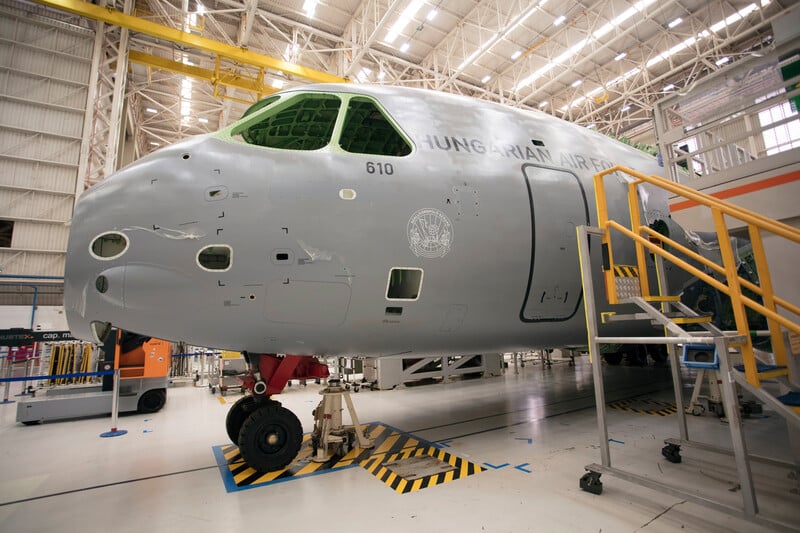Aerospace
Embraer advances in the production of the first KC-390 Millennium for Hungary
Embraer advances in the production of the first KC-390 Millennium for Hungary

The first KC-390 Millennium aircraft for the Hungarian Defense Forces is still being produced by Embraer. In order to improve the capabilities of the Hungarian Defense Forces, the Hungarian government signed a contract with Embraer in November 2020 for the purchase of two KC-390 aircraft. The aircraft’s fuselage and semi-wings are already painted in the customer’s colors, and Embraer is currently putting them together.
Beginning in the second half of 2023, the first aircraft will undergo flight tests before being delivered in the second quarter of 2024. Hungary’s second KC-390 is projected to be delivered by the end of 2024, with production for it set to start in December 2022 in keeping with the original schedule.
10 things about Embraer KC 390.(Opens in a new browser tab)
The Intensive Care Unit, a crucial component for carrying out humanitarian operations, will be installed for the first time on a KC-390 for the Hungarian Defense Forces. Not only in terms of hardware but also in terms of its avionics and communications design, the KC-390 is completely NATO-compliant. The KC-390 probe and drogue refueling system also enables the aircraft to refuel other aircraft using the same technology, including the Hungarian JAS 39 Gripen.
Aircraft comparison Brazil’s KC-390 vs Japan’s Kawasaki C-2(Opens in a new browser tab)
The aircraft completely meets the needs of the Hungarian Defense Forces and is capable of carrying out a variety of military and civilian missions, including medical evacuation, troop transport, precision cargo airdrops, operations involving paratroopers, and air-to-air refueling.
In order to work together on a project to certify Aeroplex as an Embraer Authorized Service Center in Hungary, Embraer and Aeroplex signed a Memorandum of Understanding in June 2022. The plan is to assist and make it possible for Aeroplex to maintain KC-390 Millennium aircraft for the Hungarian Defense Forces.
L3 Harris to Develop New Agile Tanker via KC-390 to Support Air Force(Opens in a new browser tab)

Aerospace
Boeing Transfers Rocket Stage to NASA, Paving Way for Human Moon Mission

Boeing has achieved a significant milestone by providing NASA with the second core stage of the Space Launch System (SLS) rocket.
This crucial component, crafted at NASA’s Michoud Assembly Facility (MAF), is set to propel the Artemis II crew into lunar orbit, marking humanity’s return to deep space after a 50-year hiatus.
The monumental Boeing-built rocket stage, the largest element of the Artemis II mission, will embark on a journey aboard the Pegasus barge, traveling 900 miles to NASA’s Kennedy Space Center.
Comparison of two legendary aircraft B777x vs B747 aircraft:Click here
Upon arrival, it will be meticulously integrated with other essential Artemis II components, including the upper stage, solid rocket boosters, and NASA’s Orion spacecraft within the iconic Vehicle Assembly Building. This intricate integration process is a vital step toward the eagerly anticipated Artemis II launch, slated for 2025.
“Boeing-built products helped land humankind on the moon in 1969, and we’re proud to continue that legacy through the Artemis generation,” remarked Dave Dutcher, vice president and program manager for Boeing’s SLS program. “Together, with NASA and our industry partners and suppliers, we are building the world’s most capable rocket and paving the way to deep space through America’s rocket factory in New Orleans.”
NASA, Lockheed Martin Reveal X-59 Quiet Supersonic Aircraft:Click here
The delivery of Core Stage 2 marks a significant achievement in the evolution of the SLS rocket. Towering over 200 feet and powered by four RS-25 engines, this core stage, coupled with two solid-fueled booster rockets, will generate a staggering 8.8 million pounds of thrust. This immense power is crucial to launching Artemis II and future missions into the vast expanse of space.
The SLS rocket stands unparalleled in its capability to transport both crew and substantial cargo to the moon and beyond in a single launch. Its extraordinary capacity will facilitate the delivery of human-rated spacecraft, habitats, and scientific missions to destinations including the moon and Mars, ushering in a new era of space exploration.
-

 Travel1 week ago
Travel1 week agoAir India to Expand US Operations with Three New Routes After a Decade
-

 Travel2 weeks ago
Travel2 weeks agoWhy We Should Avoid These Stamps in a Passport
-

 Airlines1 month ago
Airlines1 month agoInvestigations Reveal Fake Chinese Titanium in Boeing and Airbus Jets
-

 Tech4 weeks ago
Tech4 weeks agoChina’s CATL Plans 1,800-Mile Electric Plane Launch by 2027
-

 Airport3 days ago
Airport3 days agoTop 10 Largest Airports in the World by Size
-

 Aerospace4 weeks ago
Aerospace4 weeks agoChina’s Fighter Jets Turn Wings into Autonomous Drones
-

 Airlines4 days ago
Airlines4 days agoAir India Rolls Out A350s for Delhi-New York JFK and Newark Routes
-

 Defence3 weeks ago
Defence3 weeks agoBoeing Enhances Chinook with New Engines and Block II Upgrades at $96 Million







